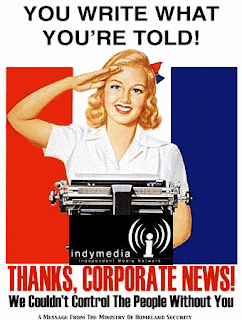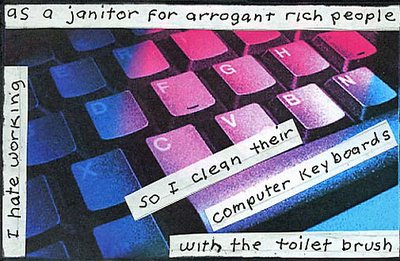The music
industry, along with many others, has had to constantly keep up with the
technological advances that continually redefine the industry itself. The evolution of how consumers obtain their
music is one that has had multiple technological alterations and these
innovations do not seem to be slowing down. This ever-changing digital culture
we live in has stirred up some major issues within the music business, but has
also created ways to reach fans that would never be possible without technology.
Technology has formed new genres of music, allowed more places to market an
artist or band, new ways to generate revenue, created a place for fans to
interact with one another and with the artist directly, and has set a global
stage for artists to get their music out to anyone, anywhere in the world. In
my opinion, technology has impacted the music industry more so than any other
field.
My Digital
Culture Senior Seminar course formed a Facebook page where we could each post
trends on topics that interest us individually. These topics had to pertain to
digital culture in some way and being that I want to pursue a career in the
music business I found that digital culture within the music industry was the
trend for me. Not only did I find articles that interested me, but the
information I found was extremely beneficial to know about the industry I hope
to become a part of one day. Most of my links I found on a popular music business blog
site known as hypebot.com but other sources included Rolling Stone Magazine,
The Wall Street Journal, Billboard, and other music industry blogs. I shared a
total of thirteen articles and in this blog I will discuss the five that stuck
with me the most.
The music business is one of the most
competitive industries with millions of people trying to do the same thing. Of
course the music itself will be different but listeners will always compare a
new artist to an established artist. There are many ways to make an artist or
band stand out, and how they market themselves is one of the concepts that have
changed drastically with the developments of technology. One of the first
articles that I shared on the group page discusses three up-and-coming bands
and their new graphic marketing techniques that has set them apart from the
rest. These marketing techniques include the creation of an iBook for fans to
watch while listening to the album, an interactive video to watch while
listening to a particular song, and a creative vinyl packaging style that comes
to life when fan opens it. Here you can watch how the vinyl album comes to life while opening the album. Vinyl Packaging for Machine, dear Album.
In my
opinion, the one marketing technique that has the potential to take off would
be the iBook. Almost everyone on the planet has a smart phone that has the
capability to listen to music and watch videos whenever and wherever they want.
It creates a brand new way for people to listen to music providing more of an
experience and an emotional rollercoaster for the fan to jump on. Digital music
sales have already surpassed CD sales according to Billboard Magazine and I
believe CDs will eventually fizzle away just like the cassette did years ago.
These are fun and innovative ways to get the listener more involved while
listening to the music. I look forward to seeing different marketing styles
that promote and differentiate an artist or band.
![[CHART]](http://si.wsj.net/public/resources/images/MK-BS868_CHART_NS_20120313180603.jpg) According to Wall Street Journal, Billboard
Magazine added online streaming as a new category to its charts just last
month. Being the huge music fan that I am, I look at the charts pretty
regularly and when I heard this I was shocked. Its crazy to think that those
songs you listen to on Pandora or Spotify are now recorded and put into charts
in Billboard Magazine. Labels make 70 cents or more per song downloaded and
less than a penny for every song streamed online. Knowing the huge difference
in revenue it is even more shocking that they would form this as a whole new
category worth noticing in the charts. I quickly saw why they did decide to
count online streaming as a new chart group after I saw the number of
audio-songs streamed compared with the number of paid downloaded songs. After seeing the statistics in front of me I can't imagine how Billboard could ignore the numbers themselves. The popularity of online streaming sites just shows that people want to be able to control of what they listen to and to be introduced to new artists.
According to Wall Street Journal, Billboard
Magazine added online streaming as a new category to its charts just last
month. Being the huge music fan that I am, I look at the charts pretty
regularly and when I heard this I was shocked. Its crazy to think that those
songs you listen to on Pandora or Spotify are now recorded and put into charts
in Billboard Magazine. Labels make 70 cents or more per song downloaded and
less than a penny for every song streamed online. Knowing the huge difference
in revenue it is even more shocking that they would form this as a whole new
category worth noticing in the charts. I quickly saw why they did decide to
count online streaming as a new chart group after I saw the number of
audio-songs streamed compared with the number of paid downloaded songs. After seeing the statistics in front of me I can't imagine how Billboard could ignore the numbers themselves. The popularity of online streaming sites just shows that people want to be able to control of what they listen to and to be introduced to new artists.
The third article that instantly caught my eye
unveiled the concept of an artist reaching a certain level of stardom and
creating his or her own social media network. This artist that the article
discusses is the one and only Lady Gaga. I am not a huge fan of the woman but
she is definitely someone who knows how to brand herself and create a loyal
community all around the world. Her network that opened its doors to the public
in March is a combination of Facebook, Twitter, Pinterest, and even MySpace. It
is a place where Gaga fans, or as she calls them “Little Monsters,” can create their
own profile, share pictures, and discuss all things Gaga. Lady Gaga herself is
what draws people to the site because she actually goes and likes certain
pictures or will interact with users directly. The network is named “Little
Monsters” in dedication to her fans. This new network is a step towards
diminishing the barriers between the fans and the artist.
A very controversial and important question in the music
industry today is whether or not record labels will be significant in the
coming years due to technology providing new platforms to distribute music. The
article I shared described an artist, Ryan O’Neal, leaving his label due to the
promotion and revenue he receives from the online streaming sites and digital
downloads. It’s the new do-it-yourself concept that has become more popular due
to technological innovations. O’Neal
says that whether or not an artist needs a record label solely depends on the
artist themselves. With technology rapidly changing who knows the future of
record labels.
The most recent story I posted on the Digital
Culture Facebook page was about the reappearance of deceased artist Tupac at
the Coachella festival in California. According to the blog Wired, “dying is the best
career move that a musician can make, but it tends to have a harmful effect on
tour revenues.” This statement is no longer relevant with the capability of
holograms thanks to the developments of technology. Tupac died in 1996 but came
back to life over the past weekend to perform with Snoop Dog at the popular
festival. The performance instantly blew up social media sites with both
positive and negative feedback. If they can recreate a person after he or she
is dead and create a brand new performance of vocals of the deceased person it
almost scares me to think of what all they can do. I can’t imagine what it was
like to witness that in person. Who knows where technology will take live
performances in the future. Here is the performance for you to watch and make your own opinions.


















